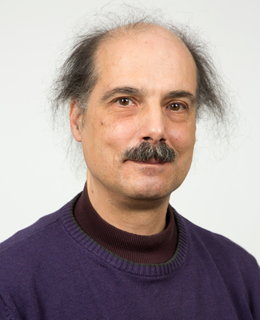
Dr. Robert Martinuzzi
Positions
Professor
Schulich School of Engineering, Department of Mechanical and Manufacturing Engineering
Associate Head (Research)
Schulich School of Engineering, Department of Mechanical and Manufacturing Engineering
Contact information
Phone number
Office: 403.220.6627
Background
Educational Background
Dr.-Ing. Lehrstuhl für Strömungs mechanic Uni-Erlangen,
MSc Queen's University,
BEng McGill University,
Biography
Professor Robert Martinuzzi, P. Eng. and Fellow of the ASME, is a Pratt & Whitney Canada Research Fellow and Professor of Fluid Mechanics.
His fundamental area of research is the physics of turbulent, separated flows. His research strategy includes the development of reduced or low-order models for inter-scale energy transfer dynamics and applications to flow control as well as developing strategies for machine learning control. He is an expert in non-intrusive experimental techniques, especially in optical velocimetry (PIV, LDV). His work focuses on transport phenomena in bluff-body wakes, turbulent wakes, remote-sensing and fluid-structure interactions.
Dr. Martinuzzi's applied research focuses on unsteady load predictions on structures, closed-loop control of separated wakes vortex-induced vibrations, aerodynamics in high-speed aviation compressors and power turbines as well as scouring and erosion in river systems.
Research
Areas of Research
Fundamental focus is on developing low-order models of the dynamics of turbulent bluff body wakes. This work aims to understand the influence of body shape and on-coming flow on: (i) aerodynamic loading on structures; (ii) mixing properties of the wake and (iii) turbulence characteristics. Low-order models are developed to model the wake dynamics and predict loading and mixing characteristics. The physics of vortex structure interactions and inter-scale energy exchanges is investigated for the purpose of the role of large-scale instabilities in the generation of turbulence and dispersion of scalar quantities (temperature or contaminants). The experimental research includes development of optical diagnostic techniques, vortex and feature identification techniques and real-time visualizations for virtual environments.
The objective of the work is to develop model-free closed-loop flow control strategies. The basic principle is based on genetic search algorithms and evolutionary algorithms to guide actuation of flow control devices to achieve drag reduction, mixing control or manipulation of unsteady forces. In this context, genetic programming is used to design the controller, a mathematical model describing how to use a sensor signal to guide the actuation signal, to achieve a desired effect. Examples include suction and/or blowing at critical locations on a body surface to reduce drag or increase mixing. The techniques are well suited for multi-objective optimization. An important aspect of this work is robust implementation in real systems and reliability.
Semi-empirical and analytical techniques are developed for real-time estimation of flow dynamics and large-scale forces from sensor data obtained from locations removed from the flow domain or body of interest. Briefly, estimation algorithms are trained using experimental or CFD data to predict flow behaviour in full-scale environments. Examples of applications include: prediction fluctuating wind patterns in the wake of large structures from a small number ground measurements, flow patterns in large scale vessels based on wall-pressure measurements, prediction of flow-induced vibrations in pipelines or bridges; or wind gusts based on wall measurements.
Participation in university strategic initiatives
Courses
| Course number | Course title | Semester |
|---|---|---|
| ENME 597 | Turbomachinery | |
| ENME603 | Physical Fluid Dynamics | |
| ENME708 | Turbulence |
Are you the profile owner?
Login to edit.
